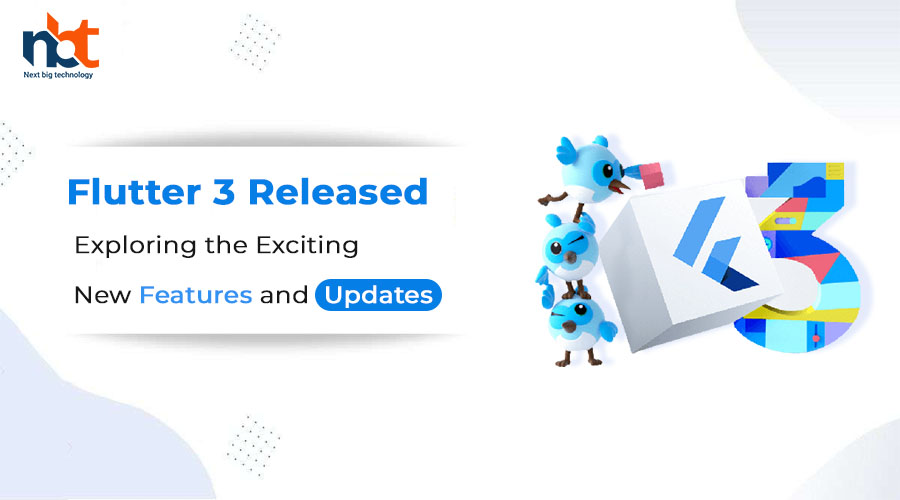Table of Contents
Introduction:
Flutter, the popular open-source UI toolkit, has gained significant traction among developers for building beautiful and performant cross-platform applications. With the recent release of Flutter 3, the Flutter community is abuzz with anticipation for the latest features and updates. In this blog, we will delve into the exciting new additions in Flutter 3, highlighting the advancements that enhance development productivity, improve app performance, and expand the capabilities of the framework. Whether you’re an experienced Flutter developer or just getting started, this comprehensive overview will keep you up to date with the latest advancements in the Flutter ecosystem.
Flutter 3 Features and Updates
Null Safety:
One of the most significant additions in Flutter 3 is the introduction of null safety. This feature eliminates null reference exceptions by providing explicit null safety annotations and introducing the concept of non-nullable types. With null safety, developers can write more reliable and robust code, reducing the likelihood of runtime errors caused by null values.
Sound Null Safety Migration:
To ease the transition to null safety, Flutter 3 introduces a sound null safety migration tool. This tool analyzes your codebase and provides suggestions and fixes to migrate your existing Flutter projects to the null safety model. It streamlines the migration process and ensures a smooth upgrade to Flutter 3 for projects built on earlier versions.
Performance Improvements:
Flutter 3 brings several performance enhancements that further elevate the user experience. The new framework optimizations result in faster app startup times, reduced memory usage, and improved rendering performance. These optimizations allow Flutter apps to provide a snappier and more fluid experience, even on low-end devices.
Flutter for Web Enhancements:
Flutter for Web continues to evolve in Flutter 3 with several notable enhancements. The framework now provides better support for keyboard and mouse interactions, making web apps feel more native and intuitive. Additionally, the web renderer has been optimized to deliver improved performance and compatibility across different browsers.
New UI Components:
Flutter 3 introduces a set of new and updated UI components that enhance the visual appeal and functionality of Flutter apps. The new components include redesigned buttons, sliders, switches, and checkboxes, providing more customization options and better adherence to platform-specific design guidelines. These new UI components enable developers to create visually stunning and intuitive user interfaces.
Flutter Desktop:
Flutter’s support for desktop platforms continues to mature in Flutter 3. The desktop support enables developers to build cross-platform applications for Windows, macOS, and Linux. With Flutter 3, the desktop framework receives updates and bug fixes, making it more stable and suitable for production-level applications. Developers can leverage Flutter’s code-sharing capabilities to create consistent experiences across mobile and desktop platforms.
Improved DevTools:
Flutter DevTools, the powerful debugging and performance analysis tool, receives updates in Flutter 3. The DevTools now offer enhanced profiling capabilities, allowing developers to analyze and optimize their apps’ performance in more detail. With improved insights into frame rendering, CPU usage, and memory allocation, developers can fine-tune their Flutter apps for optimal performance.
Enhanced Accessibility:
Accessibility is a key aspect of building inclusive applications. Flutter 3 introduces accessibility improvements, making it easier for developers to create apps that are accessible to a broader range of users. The framework now provides better support for screen readers, improved semantics, and accessibility APIs, ensuring a seamless experience for users with visual impairments or other accessibility needs.
Localization and Internationalization:
Localization and internationalization are essential for reaching a global audience. Flutter 3 enhances support for internationalization by introducing new tools and libraries that simplify the localization process. Developers can easily translate their app’s text, formats, and content into multiple languages, enabling broader market reach and localization customization.
Flutter Community Contributions:
Flutter’s vibrant community continues to contribute to the framework’s growth and improvement. Flutter 3 incorporates numerous community-driven packages, plugins, and libraries that extend the capabilities of Flutter. These community contributions enrich the Flutter ecosystem, providing developers with a wealth of ready-to-use solutions for common challenges.
Conclusion:
Flutter 3 marks another significant milestone in the evolution of the Flutter framework, introducing exciting new features and updates that enhance development productivity, improve performance, and expand the capabilities of Flutter apps. The introduction of null safety, performance improvements, Flutter for Web enhancements, new UI components, and other updates further solidify Flutter as a versatile and powerful choice for building cross-platform applications. Whether you’re a seasoned Flutter developer or exploring the framework for the first time, embracing Flutter 3 opens up new possibilities for creating visually stunning, performant, and accessible applications across mobile, web, and desktop platforms. Stay up to date with the latest Flutter advancements and leverage the new features in Flutter 3 to build exceptional user experiences and shape the future of app development.
Thanks for reading our post “Flutter 3 Released: Exploring the Exciting New Features and Updates”. Please connect with us to know more about Flutter App Development.










